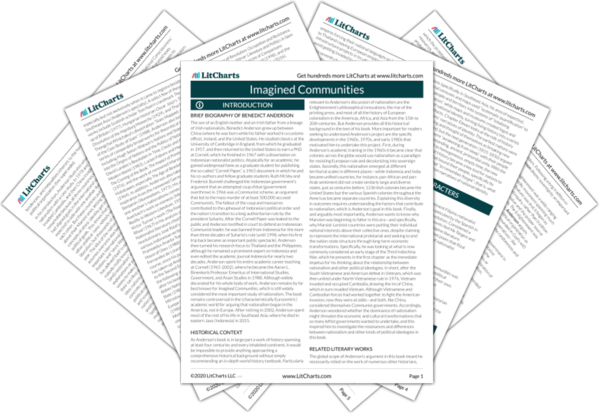Vernacular Quotes in Imagined Communities
It remains only to emphasize that in their origins, the fixing of print-languages and the differentiation of status between them were largely unselfconscious processes resulting from the explosive interaction between capitalism, technology and human linguistic diversity. But as with so much else in the history of nationalism, once “there,” they could become formal models to be imitated, and, where expedient, consciously exploited in a Machiavellian spirit.

Unlock explanations and citation info for this and every other Imagined Communities quote.
Plus so much more...
Get LitCharts A+As noted earlier, the strange physical juxtaposition of Malays, Persians, Indians, Berbers and Turks in Mecca is something incomprehensible without an idea of their community in some form. The Berber encountering the Malay before the Kaaba must, as it were, ask himself: “Why is this man doing what I am doing, uttering the same words that I am uttering, even though we can not talk to one another?” There is only one answer, once one has learnt it: “Because we … are Muslims.” There was, to be sure, always a double aspect to the choreography of the great religious pilgrimages: a vast horde of illiterate vernacular-speakers provided the dense, physical reality of the ceremonial passage; while a small segment of literate bilingual adepts drawn from each vernacular community performed the unifying rites, interpreting to their respective followings the meaning of their collective motion. In a pre-print age, the reality of the imagined religious community depended profoundly on countless, ceaseless travels. Nothing more impresses one about Western Christendom in its heyday than the uncoerced flow of faithful seekers from all over Europe, through the celebrated “regional centres” of monastic learning, to Rome.
At the same time, we have seen that the very conception of the newspaper implies the refraction of even “world events” into a specific imagined world of vernacular readers; and also how important to that imagined community is an idea of steady, solid simultaneity through time. Such a simultaneity the immense stretch of the Spanish American Empire, and the isolation of its component parts, made difficult to imagine. Mexican creoles might learn months later of developments in Buenos Aires, but it would be through Mexican newspapers, not those of the Rio de la Plata; and the events would appear as “similar to” rather than “part of” events in Mexico.
In this sense, the “failure” of the Spanish-American experience to generate a permanent Spanish-America-wide nationalism reflects both the general level of development of capitalism and technology in the late eighteenth century and the “local” backwardness of Spanish capitalism and technology in relation to the administrative stretch of the empire.
Insofar as all dynasts by mid-century were using some vernacular as language-of-state, and also because of the rapidly rising prestige all over Europe of the national idea, there was a discernible tendency among the Euro-Mediterranean monarchies to sidle towards a beckoning national identification. Romanovs discovered they were Great Russians, Hanoverians that they were English, Hohenzollerns that they were Germans—and with rather more difficulty their cousins turned Romanian, Greek, and so forth. On the one hand, these new identifications shored up legitimacies which, in an age of capitalism, scepticism, and science, could less and less safely rest on putative sacrality and sheer antiquity. On the other hand, they posed new dangers. If Kaiser Wilhelm II cast himself as “No. 1 German,” he implicitly conceded that he was one among many of the same kind as himself, that he had a representative function, and therefore could, in principle, be a traitor to his fellow-Germans (something inconceivable in the dynasty’s heyday. Traitor to whom or to what?).












